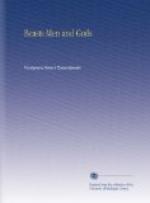The Bolsheviki from the Irkutsk district had crossed the Mongolian border, captured the Russian colony at Khathyl on the southern shore of Lake Kosogol and turned, off south toward Muren Kure, a Russian settlement beside a big Lamaite monastery sixty miles south of Kosogol. The Mongols told us there were no Russian troops between Khathyl and Muren Kure, so we decided to pass between these two points to reach Van Kure farther to the east. We took leave of our Soyot guide and, after having sent three scouts in advance, moved forward. From the mountains around the Kosogol we admired the splendid view of this broad Alpine lake. It was set like a sapphire in the old gold of the surrounding hills, chased with lovely bits of rich dark forestry. At night we approached Khathyl with great precaution and stopped on the shore of the river that flows from Kosogol, the Yaga or Egingol. We found a Mongol who agreed to transport us to the other bank of the frozen stream and to lead us by a safe road between Khathyl and Muren Kure. Everywhere along the shore of the river were found large obo and small shrines to the demons of the stream.
“Why are there so many obo?” we asked the Mongol.
“It is the River of the Devil, dangerous and crafty,” replied the Mongol. “Two days ago a train of carts went through the ice and three of them with five soldiers were lost.”
We started to cross. The surface of the river resembled a thick piece of looking-glass, being clear and without snow. Our horses walked very carefully but some fell and floundered before they could regain their feet. We were leading them by the bridle. With bowed heads and trembling all over they kept their frightened eyes ever on the ice at their feet. I looked down and understood their fear. Through the cover of one foot of transparent ice one could clearly see the bottom of the river. Under the lighting of the moon all the stones, the holes and even some of the grasses were distinctly visible, even though the depth was ten metres and more. The Yaga rushed under the ice with a furious speed, swirling and marking its course with long bands of foam and bubbles. Suddenly I jumped and stopped as though fastened to the spot. Along the surface of the river ran the boom of a cannon, followed by a second and a third.
“Quicker, quicker!” cried our Mongol, waving us forward with his hand.
Another cannon boom and a crack ran right close to us. The horses swung back on their haunches in protest, reared and fell, many of them striking their heads severely on the ice. In a second it opened up two feet wide, so that I could follow its jagged course along the surface. Immediately up out of the opening the water spread over the ice with a rush.
“Hurry, hurry!” shouted the guide.
With great difficulty we forced our horses to jump over this cleavage and to continue on further. They trembled and disobeyed and only the strong lash forced them to forget this panic of fear and go on.




